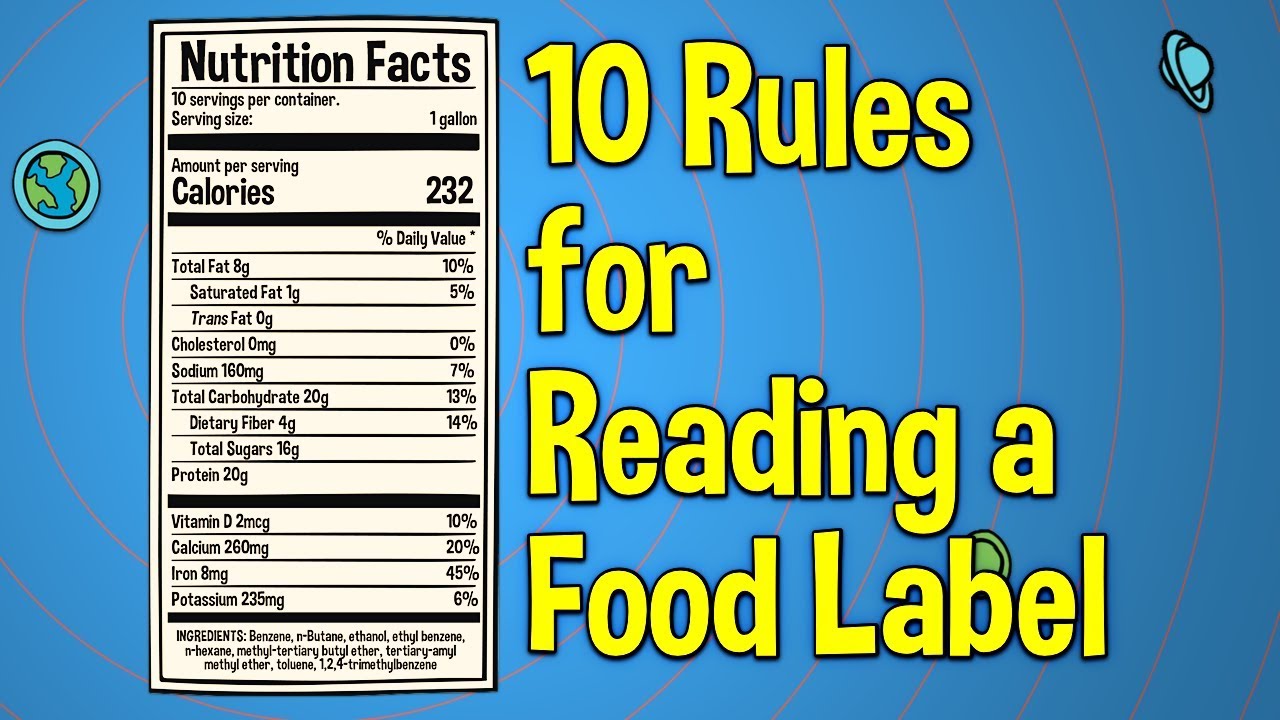Understanding Food Labels - What To Look For
With the increasing interest in healthy eating and the impact of food on our bodies, it's essential to understand the information on food labels. Understanding food labels provide essential information about the content of the food we eat, including ingredients, nutrition, and serving size. However, with so much information on the labels, it can be challenging to know what to look for.
Author:Sanah ConnorReviewer:Stefano MclaughlinFeb 22, 202368.1K Shares946.9K Views

With the increasing interest in healthy eating and the impact of food on our bodies, it's essential to understand the information on food labels.
Understanding food labelsprovide essential information about the content of the food we eat, including ingredients, nutrition, and serving size. However, with so much information on the labels, it can be challenging to know what to look for.
In this article, we will discuss what information to look for when reading food labels and how to use this information to make informed decisions about the food we eat.
Ingredients List
The ingredients list is the first place to start when reading a food label. This list shows the ingredients used in the product, listed in order of quantity, from most to least.
The ingredients used in processed foods are usually additives, preservatives, artificial colors, flavors, and sweeteners. When possible, it's best to avoid foods with a long list of ingredients, especially those that you can't pronounce or don't recognize.
Ingredients that are often used as unhealthy additives include high fructose corn syrup, trans fats, and artificial colors and flavors.
On the other hand, ingredients such as whole grains, fruits, and vegetables are generally considered to be healthy. Look for products that have a short list of recognizable ingredients and contain whole foods whenever possible.
Serving Size And Servings Per Container
The serving size and servings per container are important to consider when reading food labels, especially if you are trying to control your portions.
The serving size listed on the label is the amount of food recommended to be eaten in one sitting. The servings per container indicate the number of servings in the entire package.
It's important to pay attention to the serving size and servings per container because the calorie and nutrient information listed on the label is based on the serving size.
If you eat more than one serving, you will consume more calories and nutrients than what is listed on the label. Be sure to measure or weigh your portions to ensure you are eating the correct serving size.
Calories
Calories are a measure of the energy contained in the food we eat. When trying to manage our weight, it's essential to pay attention to the calorie content of the food we eat.
The calorie information on food labels is listed per serving size, so be sure to consider the serving size and servings per container when evaluating the calorie content of a food.
Nutrition Facts
The nutrition facts panel is an essential part of the food label and provides information about the nutrients contained in the food.
The panel includes information on total fat, saturated fat, cholesterol, sodium, total carbohydrates, dietary fiber, sugars, and protein. It also includes information on vitamins and minerals such as calcium, iron, and Vitamin C.
Total Fat
Total fat is the amount of fat in the food, including both saturated and unsaturated fats. Saturated fats are typically solid at room temperature and are often found in animal products such as meat and dairy.
Unsaturated fats, on the other hand, are liquid at room temperature and are found in foods such as nuts, seeds, and oils.
It's important to pay attention to the amount of total fat in the food and to choose foods that are low in saturated fats and high in unsaturated fats.
A diet high in saturated fats can contribute to the development of heart disease and other health problems.
Percentage Of Daily Value
The percentage of daily value is an estimate of how much of a nutrient the food provides in relation to the recommended daily intake. The daily value is based on a 2,000-calorie diet and is expressed as a percentage.
For example, if a food has 10% of the daily value of vitamin C, it means that it provides 10% of the recommended daily intake of vitamin C for a person consuming 2,000 calories per day.
Consumers should aim to eat a variety of foods that provide a range of nutrients, rather than relying on a single food for all of their nutritional needs.
Front-of-Pack Labeling
In addition to the standard food label, some food products also feature front-of-pack labeling. This labeling provides a quick and easy way to assess the healthfulness of food and is often displayed in the form of symbols, such as traffic lights or stars.
Front-of-pack labeling can be useful for consumers who are short on time and want to quickly identify healthier food options.
However, it is important to note that front-of-pack labeling is not regulated, and different companies may use different symbols or criteria to evaluate the healthfulness of a food.

10 Rules For Reading a Food Label
What Information Is Required On Understanding Food Labels?
Food labels are required to provide certain information by law in order to ensure that consumers have access to accurate and relevant information about the food they purchase. The specific information required on food labels varies depending on the country, but in general, the following information is usually required:
- Product name:The name of the food product must accurately reflect its contents and must not be misleading.
- Ingredients list:The ingredients list must be provided in descending order of weight and must list all ingredients used in the food, including any food allergens.
- Net weight:The net weight of the food must be stated, excluding the weight of any packaging.
- Manufacturer or distributor information: The name and address of the manufacturer or distributor of the food must be provided.
- Nutrition information:This includes information about the calorie, protein, carbohydrate, fat, and sodium content of the food, as well as the amounts of specific vitamins and minerals. The information must be based on a specified serving size and must be presented in a standardized format.
- Allergen information: Food labels must include information about the presence of any allergens, such as peanuts, tree nuts, dairy, wheat, and soy, that may cause adverse reactions in some individuals.
- Best-before or expiration date: The best-before or expiration date must be provided to indicate the shelf life of the food and to help consumers determine its freshness.
- Storage information:Food labels must include information about how the food should be stored, such as the recommended temperature, to ensure its safety and quality.
- Country of origin: The country of origin of the food must be indicated unless it is not possible to do so.
People Also Ask
What Is The Purpose Of Food Labels?
The purpose of food labels is to provide consumers with information about the food they are purchasing, including its ingredients, nutritional value, and storage requirements.
What Information Is Required On Food Labels?
The information required on food labels may include the product name, ingredients list, net weight, manufacturer or distributor information, nutrition information, allergen information, best-before or expiration date, storage information, and country of origin.
Why Is It Important To Understand Food Labels?
It is important to understand food labels to make informed decisions about the food you consume and to ensure that you are meeting your nutritional and dietary needs.
Are Food Labels The Only Factor That Affects Health?
No, food labels are not the only factor that affects health. A balanced diet that includes a variety of nutritious foods, regular physical activity, and adequate sleep are all important factors for maintaining good health.
Conclusion
In conclusion, understanding food labels are an important tool for consumers to make informed decisions about what they eat.
By understanding the key elements of food labels, such as serving size, calorie, and nutrient content, ingredient list, and percentage of the daily value, consumers can better assess the healthfulness of their food choices.
Additionally, front-of-pack labeling can provide a quick and easy way to evaluate the healthfulness of a food, but it is important to remember that this labeling is not regulated and may not provide a complete picture of a food's nutritional value.
While food labels can provide valuable information, it is also important for consumers to understand their own dietary needs and preferences.
For example, someone who is following a low-carbohydrate diet will need to pay attention to the carbohydrate content of foods, while someone who is following a vegetarian or vegan diet will need to look for plant-based sources of protein.

Sanah Connor
Author
Sanah Connor is a Yoga Master and expert in Nutrition, holding a Master of Public Health in Nutrition from Harvard University. With over 15 years of experience in the field, Sanah specializes in creating personalized wellness plans that promote balanced nutrition, mindful eating, and physical fitness for optimal well-being.
Beyond her professional work, Sanah is an avid advocate of holistic living and wellness. She finds fulfillment in practicing meditation, cultivating organic gardening, volunteering for community health initiatives, and indulging in creative writing. These diverse interests reflect her commitment to a well-rounded and fulfilling life, enriching both her personal and professional endeavors.
Her mission is to inspire individuals to make informed choices and embrace holistic wellness for a happier, healthier life journey.

Stefano Mclaughlin
Reviewer
Stefano Mclaughlin is a Psychologist focused on mental health, emotional well-being, and healthcare policy. He studied Psychology and Public Health at the University of Massachusetts Amherst, gaining a deep understanding of the intersection between mental health and public policy.
Stefano's mission is clear: he aims to destigmatize mental health discussions, improve access to mental healthcare, and promote emotional well-being for all. Drawing from personal experiences with anxiety and depression, Stefano shares real stories to make mental health topics more relatable and less intimidating.
In addition to his advocacy work, Stefano enjoys delving into books, experimenting in the kitchen, and embarking on new adventures. These hobbies fuel his creativity and inspire fresh perspectives for his advocacy work.
Latest Articles
Popular Articles
